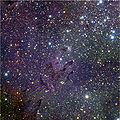Ficheiro:ESO-The Eagle Nebula.jpg

Dimensões desta antevisão: 601 × 599 píxeis. Outras resoluções: 241 × 240 píxeis | 481 × 480 píxeis | 770 × 768 píxeis | 1 027 × 1 024 píxeis | 2 053 × 2 048 píxeis | 3 000 × 2 992 píxeis.
Imagem numa resolução maior (3 000 × 2 992 píxeis, tamanho: 12,37 MB, tipo MIME: image/jpeg)
Histórico do ficheiro
Clique uma data e hora para ver o ficheiro tal como ele se encontrava nessa altura.
| Data e hora | Miniatura | Dimensões | Utilizador | Comentário | |
|---|---|---|---|---|---|
| atual | 10h14min de 13 de agosto de 2009 |  | 3 000 × 2 992 (12,37 MB) | Lars Lindberg Christensen | {{Information |Description={{en|1=Messier 16 (M16), also known as the Eagle Nebula, is located in the southern constellation of Serpens. Using the infrared multi-mode ISAAC instrument on the 8.2-m VLT ANTU telescope, European astronomers were able to ima |
Utilização local do ficheiro
A seguinte página usa este ficheiro:
Utilização global do ficheiro
As seguintes wikis usam este ficheiro:
- sk.wikipedia.org

